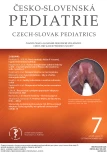A new strategy for the treatment of X-linked hypophosphatemic rickets
Authors:
Ľ. Podracká 1; M. Ilčík 2
Authors‘ workplace:
Detská klinika Lekárskej fakulty Univerzity Komenského a Národného ústavu detských chorôb, Bratislava, Slovensko
1; Rádiodiagnostické oddelenie Národného ústavu detských chorôb, Bratislava, Slovensko
2
Published in:
Čes-slov Pediat 2021; 76 (7): 360-367.
Category:
Original Papers
Overview
X-linked hypophosphataemia (XLH) is the most common hereditary hypophosphataemia with a prevalence of 1:20,000. The disease affects both sexes equally. XLH is manifested in childhood with typical clinical signs of rickets such as short stature, bone pain and skeletal deformities. The disease is characterized by the laboratory finding of chronic hypophosphatemia, normocalcemia and normal and/or only slightly elevated PTH.
The cause of XLH is a mutation in the PHEX gene (phosphate regulating endopeptitase). Mutations in the PHEX gene lead to significantly increased circulating concentrations of FGF23, a regulatory hormone (phosphatonin), resulting in decreased tubular phosphate reabsorption and impaired bone mineralization. Conventional treatment with phosphorus and calcitriol supplementation may be partially effective in some individuals, but has significant side effects. Targeted pathogenetic treatment with a monoclonal antibody (burosumab) is now available, which binds excess FGF-23 in the circulation and thus directly interferes with the pathogenetic mechanism of the disease.
We describe two rare cases of X-linked hypophosphatemic rickets successfully treated with burosumab.
Keywords:
X-linked hypophosphatemic rickets, PHEX gene, fibroblast growth factor 23, burosumab
Sources
1. Scheinman SJ, Carpenter T, Drezner MK. Hereditary hypophosphatemic rickets and tumor-induced osteomalacia. UpToDate. https://www.uptodate.com/contents/hereditary-hypophosphatemic- rickets-and-tumor-induced-osteomalacia. Retrieved April 2021; 1–29.
2. Alizadeh Naderi AS, Reilly RF. Hereditary disorders of renal phosphate wasting. Nat Rev Nephrol 2010; 6: 657–665.
3. Flogelová H, Godava M, Michálková K, et al. X-vázaná hypofosfatemická křivice – různé projevy v jedné rodině. Pediatr praxi 2020; (Suppl C): 11–15.
4. Francis F, Hennig S, Meitinger T, et al. A gene (PEX) with homologies to endopeptidases is mutated in patients with X-linked hypophosphatemic rickets. The HYP Consortium. Nat Genet 1995; 11: 130–135.
5. Bayer M. Burosumab jako novinka v léčbě hypofosfatemické křivice vázané na chromosom X. Farmakoter Revue 2020; 5: 245–250.
6. Fukuomo S. Physiological regulation and disorders of phosphate metabolism-pivotal role of fibroblast growth factor 23. Intern Med 2008; 47: 337–343.
7. Yuan B, Xing Y, Horst RL, Drezner MK. Evidence for abnormal translational regulation of renal 25-hydroxyvitamin D-1alphahydroxylase activity in the hyp-mouse. Endocrinology 2004; 145: 3804–3812.
8. Thacher T, Pettifor J, Tebben P, et al. Rickets severity predicts clinical outcomes in children with X-linked hypophosphatemia: Utility of the radiographic Rickets Severity Score. Bone 2019; 122: 76–81.
9. Feng JQ, Clinkenbeard EL, Yuan B, et al. Osteocyte regulation of phosphate homeostasis and bone mineralization underlies the pathophysiology of the heritable disorders of rickets and osteomalacia. Bone 2013; 54: 213–221.
10. Haffner D, Emma F, Eastwood DM, et al. Clinical practice recommendations for the diagnosis and management of X-linked hypophosphataemia. Nat Rev Nephrol 2019; 15: 435–455.
11. Radlovič V, Smoljanič Ž, Radlovič N, et al. X-linked hypofosfatemic rickets: Case report. Srp Arh Celok Lek 2014; 142: 75–78.
12. Polisson RP, Martinez S, Khoury M, et al. Calcification of entheses associated with X-linked hypophosphatemic osteomalacia. N Engl J Med 1985; 313: 1–6.
13. Linglart A, Biosse-Duplan M, Briot K, et al. Therapeutic management of hypophosphatemic rickets from infancy to adulthood. Endocr Connect 2014; 3: 13–30.
14. Alon US Monzavi R, Lilien M, et al. Hypertension in hypophosphatemic rickets role of secondary hyperparathyroidism. Pediatr Nephrol 2003; 18: 155–158.
15. Keskin M, Savaş-Erdeve S, Sağsak E, et al. Risk factors affecting the development of nephrocalcinosis, the most common complication of hypophosphatemic rickets. J Pediatr Endocrinol Metab 2015; 28: 1333–1337.
16. Vaisbich MH, Koch VH. Hypophosphatemic rickets: results of a long-term follow-up. Pediatr Nephrol 2006; 21: 230–234.
17. Skálová S, Rozsívalová P, Koberová Ivančáková I. X-vázaná hypofosfatemie u dvou sourozenců – možnosti a úskalí konvenční terapie. Sborník kazuistik pacientu s X-vázanou hypofosfatemickou křivicí. Pediatr praxi 2020; (Suppl C): 21–25.
18. Šuláková T. X-vázaná hypofosfatemie XLH se závažnými komplikacemi konvenční terapie. Pediatr praxi 2020; (Suppl C): 26–31.
19. Kutílek Š. Burosumab – nová naděje v léčbě hypofosfatemické křivice. Remedia 2019; 29: 1–5.
20. Šumník Z. Editorial. Pediatr praxi 2020; (Suppl C): 32.
21. Carpenter TO, Imel EA, Holm IA, et al. A clinician’s guide to X-linked hypophosphatemia. J Bone Miner Res 2011; 26: 1381–1388.
22. Aono Y, Hasegawa H, Yamazaki Y, et al. Anti‐FGF‐23 neutralizing antibodies ameliorate muscle weakness and decreased spontaneous movement of Hyp mice. J Bone Miner Res 2011; 26: 803– 810.
23. Carpenter TO, Whyte MP, Imel EA, et al. Burosumab therapy in children with X-linked hypophosphatemia. N Engl J Med 2018; 378: 1987–1998.
24. Imel EA, Glorieux FH, Whyte MP, et al. Burosumab versus conventional therapy in children with X-linked hypophosphataemia: a randomised, active-controlled, open-label, phase 3 trial. Lancet 2019; 393: 2416–2427.
25. Whyte MP, Carpenter TO, Gottesman GS, et al. Efficacy and safety of burosumab in children aged 1–4 years with X‐linked hypophosphataemia: a multicentre, open‐label, phase 2 trial. Lancet Diabetes Endocrinol 2019; 7: 189–199.
Labels
Neonatology Paediatrics General practitioner for children and adolescentsArticle was published in
Czech-Slovak Pediatrics

2021 Issue 7
Most read in this issue
- Laryngomalacia – when to operate?
- Newborn resuscitation and support of transition of infants at birth 2021
- Non-surgical treatment of pectus excavatum in children
- A new strategy for the treatment of X-linked hypophosphatemic rickets
